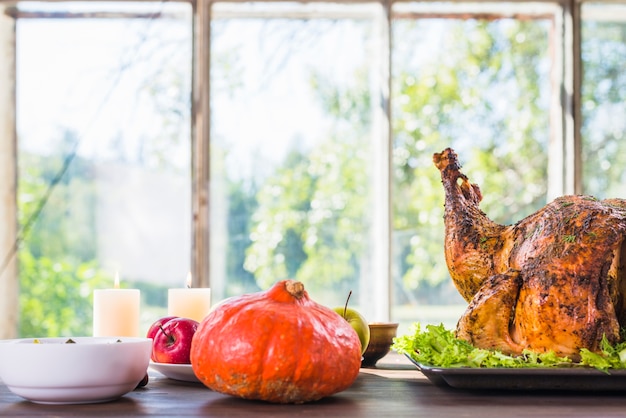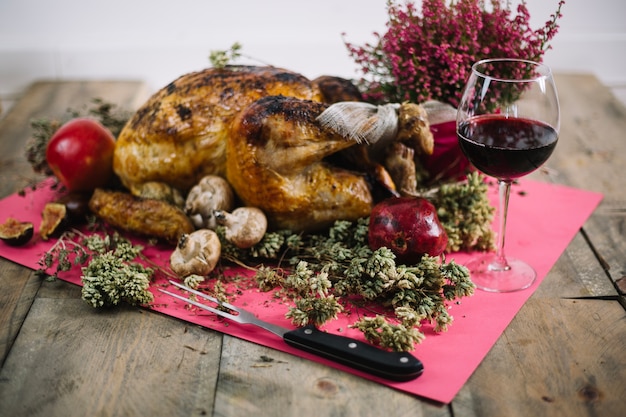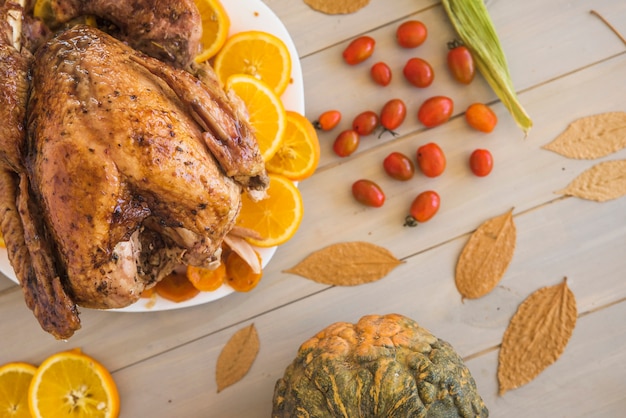Part 1: The Magic of Brining

Why Bother?
We all know that dry, flavorless turkey can be a real buzzkill. But brining transforms the whole experience. It’s all about moisture, and a brined turkey is like a sponge that's been soaking in deliciousness. The simple explanation? Brining uses a salt-water solution, and through osmosis, draws moisture from the outside of the turkey into the meat. This process makes the turkey incredibly juicy, tender, and full of flavor. Imagine biting into a turkey that’s bursting with flavor, instead of dry and disappointing. It’s a real game-changer.
Two Ways to Brine: Dry and Wet
There are two main ways to brine a turkey: dry brining and wet brining. Each method has its pros and cons, so choose the one that best suits your style and taste.
Dry Brining
Dry brining is my personal favorite. It’s simple, fuss-free, and delivers incredible results. The process involves rubbing a salt mixture generously all over the turkey, and letting it hang out in the fridge uncovered for 12-24 hours. The salt draws out moisture, but then it gets reabsorbed back into the turkey, along with flavor. Think of it as a natural, delicious marinade. Dry brining also helps create a beautiful, crispy skin, which is a bonus for those who love a good crunch.
Wet Brining
Wet brining is for those who want a more intense flavor infusion. You submerge the turkey in a brine solution, a magical concoction of salt, water, and often other ingredients like sugar, herbs, and spices. The possibilities are endless. You can create a simple brine, or get creative with citrus, garlic, rosemary, or even a touch of maple syrup. The brine works its magic, infusing the turkey with a deep, rich flavor. Wet brining requires a large pot or container to hold the turkey, and it can be a bit messier, but the delicious results are well worth it.
Part 2: Choosing the Right Bird

Size Matters
Picking the right size turkey is crucial for a successful roast. If you're cooking for a small gathering, a 10-12 lb turkey might be perfect. But for a Christmas feast with the whole family, you’ll likely need a bigger bird, somewhere between 14-16 lbs or more. Always check the label, and don't be afraid to ask the butcher for advice. They’re usually happy to help.
Fresh vs. Frozen
In my book, fresh turkeys are the way to go. They have a more intense flavor and cook more evenly. But, sometimes life throws us curveballs, and we end up with a frozen turkey. If you’re in this situation, make sure it’s thawed completely before brining and roasting. Don't even think about trying to roast a frozen turkey – it’s a recipe for disaster.
The Art of Patience
One thing I've learned about turkeys, is patience is key. Give the bird ample time to thaw completely and to brine properly. It’s worth the wait. I once tried to rush the process, and let’s just say, the turkey wasn't exactly a culinary masterpiece. A little patience goes a long way!
Part 3: The Perfect Brine Time

Dry Brining Time
For dry brining, you want to give the salt enough time to work its magic. Let the turkey sit in the fridge uncovered for 12-24 hours. The longer the better! Remember, pat the bird dry with paper towels before roasting to remove any excess moisture.
Wet Brining Time
Wet brining takes a bit longer. You’ll need to submerge the turkey in the brine for 12-24 hours, but some recipes suggest even longer, up to 48 hours. I’ve tried both, and I find that a 24-hour brine is usually enough. It’s important to make sure the turkey is completely submerged in the brine solution. And don't forget to keep it chilled, or you risk spoiling the bird.
Part 4: roasting time: The Big Moment
The Ultimate Guide to Turkey Roast Time
Now, let's talk about the heart of the matter: roasting time. The cooking time for a brined turkey will vary depending on its size. Here’s a general guide:
| turkey weight (lbs) | Roast Time (hours) |
|---|---|
| 10-12 | 2.5-3 |
| 12-14 | 3-3.5 |
| 14-16 | 3.5-4 |
| 16-18 | 4-4.5 |
But, this is just a starting point. The best way to know if your turkey is done is to use a meat thermometer. Insert it into the thickest part of the thigh, avoiding the bone. The turkey is done when the internal temperature reaches 165°F (74°C).
To Stuff or Not to Stuff
Stuffing your turkey is a matter of personal preference. But honestly, I prefer to cook stuffing separately in a casserole dish. It gives me more control over the cooking process and ensures that the stuffing is cooked thoroughly. Plus, it prevents any potential food safety risks.
Resting is Essential
Once the turkey is cooked, let it rest for at least 30 minutes before carving. This allows the juices to redistribute, resulting in a more tender and flavorful bird. It’s a crucial step that many people skip, but it’s worth the extra wait.
Part 5: Tips for a Perfect Roast
Don’t Overcrowd Your Oven
Give your turkey some space! Don’t cram it in with other dishes. It needs room to cook evenly. If you’re roasting other dishes, consider staggering them. It's a good idea to roast the turkey on its own.
The Power of Basting
Basting is your secret weapon for a moist and flavorful turkey. Use the pan drippings or broth to baste the turkey every 30-45 minutes. It keeps the skin moist and helps it brown beautifully.
Unlocking Crispy Skin
Want a crispy, golden-brown skin? Elevate the turkey on a rack in the roasting pan. This allows air to circulate around the bird, resulting in that irresistible crispy texture.
Part 6: Leftovers: A Delicious Adventure
One of the best things about roasting a turkey is the delicious leftovers. They're a blank canvas for creativity. Make sandwiches, soups, salads, or even turkey pot pie. And don't forget the gravy! I always make a big pot, enough for everyone. There’s nothing quite like a good turkey gravy to complete a festive meal.
Freezing Leftovers for Later
If you have leftovers you don’t want to eat right away, you can freeze them for later. Wrap them tightly in plastic wrap or foil and store them in the freezer for up to 3 months. Thaw them in the fridge before using.
Part 7: Food Safety: The Crucial Ingredient
Handling Raw Turkey Responsibly
Turkey is a delicious protein, but it’s also a breeding ground for bacteria. So, it's important to handle it with care to avoid food poisoning. Wash your hands thoroughly with soap and water after handling raw turkey. Wash all utensils and surfaces that come into contact with raw turkey. And remember, don't let the turkey sit at room temperature for too long.
Cooking Temperature: The Key to Safety
Cooking the turkey to the proper temperature is essential for killing off any harmful bacteria. The turkey is fully cooked when the internal temperature reaches 165°F (74°C). It’s always better to be safe than sorry.
Storing Leftovers Safely
Store leftover turkey in the fridge within two hours of cooking. Refrigerate it in shallow containers to cool quickly. This will help prevent the growth of bacteria. Don’t leave it out at room temperature for too long. Remember, you can freeze leftover turkey for up to 3 months.
Part 8: FAQs
1. Can I Brine a Turkey in the Oven?
No, you should never brine a turkey in the oven. The high temperature in the oven could cook the turkey prematurely, leaving it dry and tough. Always brine your turkey in the fridge.
2. Can I Brine a Turkey More Than Once?
It’s not recommended to brine a turkey more than once. The process of brining draws out moisture and then reabsorbs it. brining a turkey twice could make it too salty and affect the texture.
3. Can I Use a turkey roasting Bag?
Some people love turkey roasting bags. They make for a moist and tender turkey. However, using a bag can prevent the skin from getting crispy. It’s a matter of personal preference.
4. What Happens If I Overcook a Turkey?
Overcooking a turkey can lead to dry, tough meat. It's important to cook the turkey to the proper temperature but not overcook it. Use a meat thermometer to ensure the turkey is cooked through without drying it out.
5. How Do I Make Sure My Turkey is Crispy?
Elevate your turkey on a rack in the roasting pan. This allows air to circulate around the bird, leading to crispy, golden-brown skin. Another trick is to add a little butter or olive oil to the skin before roasting.
Part 9: Conclusion
Brining a turkey is a simple but powerful technique that can transform your festive feast. With a little planning and preparation, you can guarantee a juicy, flavorful turkey that will impress your guests. Don’t be afraid to experiment and find what works best for you. There are so many delicious variations to try.
So, what are you waiting for? Get brining, and have a happy holiday!
Everyone is watching

How to Cook Frozen Lobster Tails Perfectly: A Step-by-Step Guide
RecipesLobster. Just the word conjures up images of lavish meals, special occasions, and a taste of luxury. But let's...

Pigs in a Blanket Cooking Time: How Long to Bake for Perfect Results
RecipesAh, pigs in a blanket. Just the name conjures up images of those delightful little parcels of crispy pastry en...

Pork Fillet Cooking Time: How Long to Cook It Perfectly
RecipesPork fillet, or tenderloin as it's sometimes called, is a real favourite in our house. It's so versatile, and...

The Ultimate Guide to Tender, Juicy Pulled Pork
RecipesRight, let's talk pulled pork. It's one of those dishes that just screams "comfort food," doesn't it? I mean...

The Ultimate Guide to Cooking Sweet Potatoes: From Roasting to Mashing
RecipesSweet potatoes. Just the name conjures up images of warm, comforting dishes, bursts of vibrant color, and a to...
